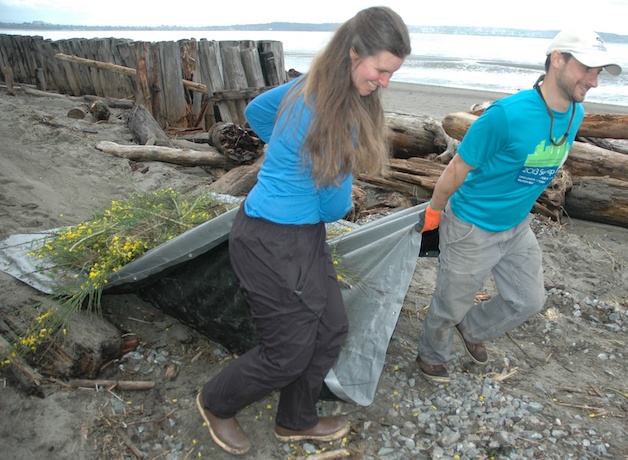TULALIP — The Marysville and Tulalip communities got into the spirit of Earth Day over the weekend.
More than 20 volunteers descended upon Mission Beach in Tulalip April 23 to remove 353 pounds of debris and a pile of Scotch broom “bigger than my VW bus,” said Andy Gregory, pollution prevention director for Puget Soundkeeper.
Gregory explained that, just below the low-tide line at the beach, critical eelgrass habitat is used by forage fish and juvenile salmon.
“Marine debris, especially micro-plastics, can contaminate this habitat and enter the food chain, where they become toxic to not only fish, but also the humans and marine mammals that consume them,” Gregory said.
Julia Gold, environmental program analyst with the Natural Resources Division of the Tulalip Tribes, identified Mission Beach as one that’s regularly used and collects a large amount of trash.
Gold elaborated on the threat of Scotch broom, a large plant that dumps thousands of seeds on the ground, where they remain viable for 30 years or more, and grows fast enough to crowd out other native plants.
“Scotch broom is a noxious weed, basically your neighborhood plant bully,” Gold said. “Over the past three years, since homes were removed from the beach, tidal action has formed a small dune on the upper beach. Native willows, rushes and dune grasses are establishing themselves, but Scotch broom seeds are arriving quickly and have formed ten-foot-high thickets.”
The Tulalip Natural Resources Department has deemed the removal of Scotch broom a high priority.
“The dune environment is a very important food source for young salmon coming from the Snohomish River,” Gold said. “They look for cover in the nearby eelgrass beds and feed near the shore during high tide.”
Gregory admitted that seeing trash left on the shoreline made him feel frustrated, but he echoed Gold as she gushed over the event’s turnout, praising the day’s volunteers as enthusiastic and hardworking.
“When we showed up in the morning, it was cold and stormy, with a strong wind and intermittent rain,” Gregory said. “As we began to work, the clouds cleared and the sun came out. One of the girls from the tribes said the sun came out because our ancestors are happy with the good work we’re doing. I am humbled to be part of this important work.”
Meanwhile, Jennings Park saw a turnout of 25 volunteers, who planted trees near the fishing pond and Allen Creek, in addition to picking up litter.
Adopt-A-Stream brought an in-stream camera, through which volunteers could view the underwater conditions of the creek and watch for wildlife, while Sound Salmon Solutions provided volunteers packets of native flower seeds, reusable water bottles and other environmentally minded prizes for correctly answering quiz questions.
The city of Marysville brought reusable bags, Earth Day T-shirts sized for children, and pet waste bags as giveaway items, in addition to supplying the 25 cedars and Douglas fir trees for planting. Kids were able to decorate their Earth Day shirts with colored markers and fish stamps.
Leah Grassl, surface water specialist for the city, believes the day’s weather affected the number of participants.
“We still had many dedicated individuals, including Boy and Girl Scout troops, who made the trek to Jennings Park to learn about streams and improve the environment,” said Grassl, who expects next year’s Earth Day will expand its scope by changing locations and recruiting more partner agencies.
“Earth Day is an excellent opportunity to meet your friends and neighbors in the community and do something to help everyone’s environment. Whether you’re learning about how an ecosystem works, planting a tree, or considering ways to reduce consumption of resources, it’s an excellent day to enjoy nature in our local parks or even your own back yard.”


